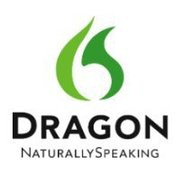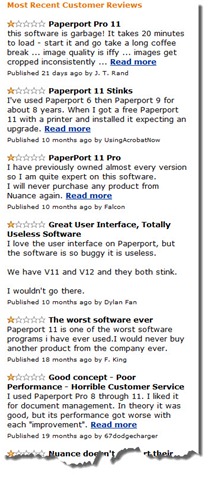I’m about two weeks into one of the more amazing experiences I’ve ever had with a computer. I don’t say that lightly; over the years I’ve had a lot of amazing experiences with computers and this really stands out.
On the other hand, there are a thousand reasons why you might not have the same experience. Before we’re done I’ll hedge this story with cautions and qualifications and defensive Ifs and Buts.
The story is this:
- About two weeks ago I installed Dragon NaturallySpeaking 11.5 Home Edition on my office computer.
- I speak into a microphone. The computer writes down what I say.
There is so much packed into that simple story that it requires a bit of context to understand why I’m so blown away. Today let’s have a history lesson. Tomorrow we’ll go through some specific information about the current version of Dragon NaturallySpeaking.
A Short History Of Speech Recognition
Speech recognition is hard, notoriously hard. Dragon has plugged away at it for decades. For most of that time the Dragon products didn’t work very well, in addition to having a ridiculously steep learning curve. In the early 2000s I saw dozens of dusty boxes of Dragon Dictate and Dragon NaturallySpeaking stuck in closets after failed attempts to use it.
Dragon NaturallySpeaking has always been the only dictation software with any name recognition. It was being regularly upgraded but things were not going well behind the scenes. In 2000 Dragon’s parent company was acquired by Lernout & Hauspie, which almost immediately was enmeshed in financial scandals and ultimately went bankrupt. The Dragon product line was acquired by Scansoft in 2001; Scansoft became Nuance Communications a few years later.
For almost a decade Scansoft/Nuance earned a reputation in my heart as the worst company in the world. Oh, sure, at times Network Solutions or AT&T would earn special recognition for boneheaded offensive evil stupidity, but Nuance was always in the running because of what it had done with a perfectly nice document organizer named Paperport. It had always been a buggy program but it took Nuance to turn it into the steaming pile that it became by the mid-2000s. You can still go revisit Amazon’s page of customer reviews for Paperport 11: “garbage,” “stinks,” “I will never purchase any product from Nuance again,” “worst software ever,” “horrible customer service.” Nuance’s other programs (Omnipage, ReadIris, PDF Converter) were no better – buggy, poorly designed and difficult to use, with no support. Ah, memories!
Meanwhile Microsoft invested large amounts of money into speech recognition research and released some limited voice recognition features for Windows XP and Office but didn’t claim much for it until Vista was released in 2006. Vista’s speech recognition was . . . pretty good. Few people discovered it but it was built into the operating system, just as it is with Windows 7. (Click on Start and type in Speech – you’ll find it.) I used it with more or less success but it was never quite right – a bit too much trouble, a bit too little reward. I set up Windows 7 Speech Recognition for my lovely wife and she struggled with it for a couple of years, and it was never quite right for the same reasons – too many microphone problems, too many errors, too much time fussing with it. I saw the same thing with other friends and clients and slowly lost my enthusiasm for Microsoft’s speech recognition.
In the summer of 2010 it was time to give Dragon another try. I bought a copy of Dragon NaturallySpeaking 10 and put the DVD in the drawer of my wife’s computer and ran the installation routine.
It failed with an incomprehensible error message.
Over the next two weeks I did thorough, exhaustive work trying to install the program. I got updates and downloaded service packs and uninstalled possibly conflicting programs and did Google searches and called Nuance, which lived down to my lowest expectations and wasted my time with a clueless tech support rep. The program never did install properly. A handful of people had a similar problem. Most people didn’t. I didn’t give it much thought because I had been predisposed to have a Nuance product fail. The box is still on the shelf. Dusty.
The More Recent History Of Nuance Communications
An odd thing happened when I wasn’t paying attention: Nuance Communications acquired and merged its way into respectability. It may even be making good software.
When it merged with Scansoft, Nuance started by blending the original Dragon technology with its own work in speech recognition dating back to the 1990s, plus bits and pieces from ViaVoice (acquired from IBM by Scansoft) and others. But starting in 2006 Nuance went on an acquisition frenzy that has included literally dozens of companies, from Dictaphone to Philips Speech Recognition Systems, plus patents from IBM and many more large and small speech technology companies. The current Dragon NaturallySpeaking products are much more than incremental upgrades of old products. Nuance has started doing the most interesting work in the world in speech recognition.
Want the proof? The proof is a single word: Siri. Apple’s much-hyped voice activated personal assistant in the iPhone 4S is reportedly built on technology provided by Nuance. (If you haven’t heard of Siri, go read this overview. It’s a big deal.)
In addition to captivating iPhone users everywhere with Siri, Nuance made an aggressive move a few days prior to the release of the iPhone 4S when it bought Swype, a highly regarded keyboard app for Android phones. Swype does not rely on spoken commands; you “type” on a Swype keyboard by moving your finger smoothly from one letter to another without lifting your finger or tapping. It uses predictive text technology to choose the word you mean with a startling degree of accuracy. With the Swype acquisition, Nuance turned itself into an input organization rather than just a voice recognition company, poised to play a leading role in a wide range of devices – phones, tablets, TVs, cars, game consoles, kiosks, who knows what else.
Reading stories about Siri and Swype made me realize that Nuance had become more interesting than I realized, but I still wasn’t prepared for what I found when I installed Dragon NaturallySpeaking 11.5. More about that tomorrow!


